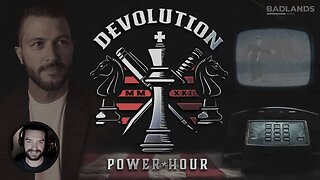Premium Only Content

Uncaptured Jews Have Been Living in the Region of Modern Iran for Nearly 3,000 Years
Jews Have Been Living in the Region of Modern Iran for Nearly 3,000 Years
Uncaptured: Jews in the Islamic Republic of Iran
The Grayzone
497K subscribers on YouTube
Join Max Blumenthal on a trip throughout Iran as he meets members of the second largest Jewish community in the region. In this collaboration with acclaimed Iranian filmmaker Maria Mavati, Blumenthal takes a look at the lives and rich history of Jews inside the Islamic Republic that might surprise outsiders, and which provides a stunning rebuke to Zionist portrayals of post-revolutionary Iran.
"I had read and heard so much about them," Blumenthal reflected on the Jewish Iranians he met during this project. "Some of it might have been true, but much of it felt like propaganda. So I wanted to see for myself – to meet Iran's Jews where they lived, in their congregations, and communities. What I found was an authentic brand of Judaism in practice, one representing thousands of years of tradition, and which today remains uncaptured by the militaristic force of Zionism."
With editing by Oscar Leon and Ahmad Hussam.
What are the details Jews in the Islamic Republic of Iran when did they get there?
Google AI Overview
Jews have been living in the region of modern-day Iran for nearly 3,000 years, since the Assyrian and Babylonian exiles of the first millennium BCE. While the community has faced periods of persecution, it has also flourished and endured, though its size has shrunk significantly since the 1979 Islamic Revolution.
Origins of the Jewish community
The earliest Jewish communities in Iran trace their history to ancient times.
Assyrian and Babylonian Captivity: The community's roots lie in the exiles of Israelites to Persia following the conquest of the Northern Kingdom of Israel by the Assyrian king Shalmaneser V in 722 BCE, and later, the conquest of Judah and Jerusalem by the Neo-Babylonian Empire in 586 BCE.
Cyrus the Great: After conquering Babylon, the Persian emperor Cyrus the Great famously allowed the Jewish exiles to return to Jerusalem in 539 BCE. Many returned, but many others chose to remain in Persia, establishing a large and influential community. The biblical Book of Esther is set in this period.
Integration and Identity: Over centuries, Iranian Jews became well-integrated into Persian society, while largely maintaining their distinct religious and cultural identity. Today, Iran has the second-largest Jewish population in the Middle East after Israel, though it is far smaller than its peak.
Life under the Islamic Republic
After the 1979 Islamic Revolution and the establishment of the Islamic Republic of Iran, the status of the Jewish community changed dramatically.
Exodus of Jews: A majority of Iran's Jewish population, which numbered between 80,000 and 100,000 at the time of the revolution, fled the country. Reasons for the mass emigration included fears of religious persecution and political instability, as well as the execution of Jewish community leader Habib Elghanian on false charges of Zionism.
Current population and locations: Today, Iran's Jewish population is estimated to be between 8,000 and 15,000, residing primarily in Tehran, Isfahan, and Shiraz.
Discrimination and restrictions: While the constitution recognizes Jews as a protected religious minority and reserves one seat for a Jewish representative in parliament, discriminatory practices persist. Jews are barred from holding senior government or military positions, and their testimony in court holds less weight than that of a Muslim.
"Protected" status: The Iranian government distinguishes between the Jewish population and Zionists, with Ayatollah Khomeini declaring that Jews are a protected minority. However, this "protection" has often been described as conditional and coercive, requiring the community to publicly demonstrate loyalty to the regime, sometimes in a humiliating manner.
Community life and worship: Despite the limitations, Jewish life continues in Iran. There are active synagogues, kosher shops, and Jewish schools, particularly in Tehran. The synagogues have reportedly become more central to the community's social life.
Forced declarations: Members of the Jewish community are sometimes pressured to make statements or condemnations in line with the government's anti-Zionist stance, creating a precarious situation for Iranian Jews.
Resilience and identity: Many of the Jews who have remained in Iran feel a deep connection to their Persian heritage and home. They see themselves as Iranians first and have chosen to endure the difficult conditions rather than leave.
Join the Weekly Video Call
constitutionhelp.com
-
 LIVE
LIVE
Badlands Media
7 hours agoDevolution Power Hour Ep. 402
7,250 watching -
 2:05:48
2:05:48
Inverted World Live
6 hours agoUFO Seen Over Tokyo During Trump Visit | Ep. 132
48.3K10 -
 2:54:08
2:54:08
TimcastIRL
4 hours agoDemocrat FEDERALLY INDICTED For Obstructing ICE Agents In Chicago | Timcast IRL
181K81 -
 LIVE
LIVE
SpartakusLIVE
6 hours agoNEW - REDSEC Battle Royale || The Duke of Nuke CONQUERS ALL
341 watching -
 LIVE
LIVE
PandaSub2000
1 day agoLIVE 10:30pm ET | NINTENDO DS Night
203 watching -
 LIVE
LIVE
Alex Zedra
3 hours agoLIVE! Battlefield RecSec
273 watching -
 1:26:50
1:26:50
The Quartering
4 hours agoErika Kirk Threatened, SNAP Riots Near, & New AstroTurfed Woke Lib Influencer
30.6K18 -
 29:24
29:24
Glenn Greenwald
6 hours agoSen. Rand Paul on Venezuela Regime Change, the New War on Drugs, MAGA Rifts, and Attacks from Trump | SYSTEM UPDATE #539
100K105 -
 1:45:39
1:45:39
Badlands Media
17 hours agoAltered State S4 Ep. 3
40.8K24 -

This is the Ray Gaming
2 hours ago $0.01 earnedRedacted Sector Day 2 | Rumble Premium Creator
9.79K4